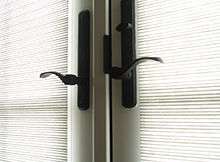Casement window
.jpg)
A casement is a window that is attached to its frame by one or more hinges at the side.[1][2] They are used singly or in pairs within a common frame, in which case they are hinged on the outside. Casement windows are often held open using a casement stay. Windows hinged at the top are referred to as awning windows, and ones hinged at the bottom are called hoppers.
_Light.jpg)
In the United Kingdom, casement windows were common before the sash window was introduced, and usually metal with leaded glass—glass panes held in place with strips of lead (called lead "cames"; leaded glass is not to be confused with lead glass, which refers to the manufacture of the glass itself).[3] These casement windows usually were hinged on the side, and opened inward. By the start of the Victorian era, opening casements and frames were constructed from timber in their entirety. The windows were covered by functional exterior shutters, which opened outward. Variants of casement windows are still the norm in many European countries.
They are opened with a crank, lever, or cam handle, which is placed around hand height or at the bottom and serves as a window lock.[4] A crank, stay, or friction hinge is necessary when the window opens outward, to hold the window in position despite wind.
Often the glass panes are set in a rabbeted frame and sealed with beveled putty or glazing compound to secure the glass.
Casement windows are labelled in one of two ways. FCL refers to a left-handed window, where the hinges are located on the left and the locking mechanism is on the right. FCR is a right-handed window with the hinges on the right and the locking mechanism on the left. Remember, these definitions apply to a window when looking at it from the exterior. In some countries diagrams of casement windows show a dashed triangle with the hinged side identified by the point of the triangle (e.g. USA), while in others they point to the lever, showing a simplified perspective of the opened window (e.g. Hungary). Furthermore in some countries (e.g. Hungary) diagrams also make distinction between windows opening towards the viewer (dashed line) or outwards (solid line). FCL windows feature a triangle pointing to the left; FCR windows have a triangle pointing to the right.
Casement windows "generally have lower air leakage rates than sliding windows because the sash closes by pressing against the frame."[5]
Casement windows and natural ventilation
Casement windows are also excellent for natural ventilation strategies, especially in hot climates. They can be hinged to open outward and angled in order to direct breezes into the building.
- Out-swinging shutter, in-swinging window
 Danish casement window
Danish casement window Casement window on Crete
Casement window on Crete
- Casement window
 Casement window swinging in
Casement window swinging in Window locks use lever handles
Window locks use lever handles
| Look up casement in Wiktionary, the free dictionary. |
Notes
- ↑ Poppeliers, Chamers, Jr.; Schwartz (1983). What Style is it?. NY: John Wiley and Sons. p. 98. ISBN 0-471-14434-7.
- ↑ "Casement window vs sash window comparison". The Sash Window Workshop.
- ↑ "Casement window". Illustrated Architectural Dictionary. Archived from the original on 2007-12-24. Retrieved 2008-01-18.
- ↑ Ching, Francis (1997). A Visual Dictionary of Architecture. New York: Van Nostrand Reinhold. pp. 113, 116, 273. ISBN 0-442-02462-2.
- ↑ "Energy-Efficient Windows - Department of Energy". energy.gov. Retrieved 16 March 2018.